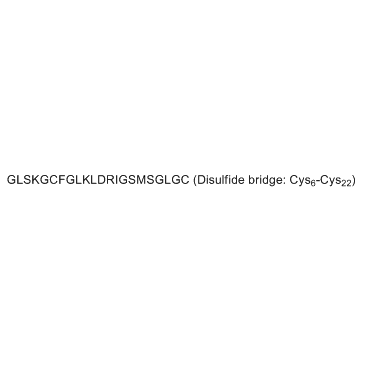C型利钠肽(CNP)(1-22),人

C型利钠肽(CNP)(1-22),人结构式

|
常用名 | C型利钠肽(CNP)(1-22),人 | 英文名 | C-Type Natriuretic Peptide (32-53) (human, porcine, rat) acetate salt |
|---|---|---|---|---|
| CAS号 | 127869-51-6 | 分子量 | 2197.60000 | |
| 密度 | N/A | 沸点 | N/A | |
| 分子式 | C93H157N27O28S3 | 熔点 | N/A | |
| MSDS | 中文版 美版 | 闪点 | N/A |
C型利钠肽(CNP)(1-22),人用途C-Type Natriuretic Peptide (CNP) (1-22), human人是C-型钠尿肽的1-22片段。 C-type natriuretic peptide是利尿钠肽家族肽,其参与维持电解质-液体平衡和血管张力。 |
| 中文名 | C型利钠肽(CNP)(1-22),人 |
|---|---|
| 英文名 | Natriuretic peptide, C-type |
| 英文别名 | 更多 |
| 描述 | C-Type Natriuretic Peptide (CNP) (1-22), human人是C-型钠尿肽的1-22片段。 C-type natriuretic peptide是利尿钠肽家族肽,其参与维持电解质-液体平衡和血管张力。 |
|---|---|
| 相关类别 | |
| 体外研究 | C型利钠肽(CNP)已被证明存在于哺乳动物的中枢神经系统中,并参与调节体液的稳态,电解平衡和血压,学习和记忆[1]。 |
| 体内研究 | 在施用肽后24小时和48小时,以2nM的剂量施用C-型利钠肽(CNP)(1-22)诱导增加印防毒素-点燃惊厥的严重性[1]。 |
| 动物实验 | 大鼠[1]大鼠预先用印防己毒素点燃,并监测惊厥。然后大鼠在自由行为的条件下接受Icv施用C-型利钠肽(CNP)(1-22)(0.2,1或2nM,在2mcl的0.9%NaCl中)。对照动物接受等体积的盐水。在注射肽后10分钟内,腹膜内施用印防己毒素(1.5mg / kg)并如上所述评估惊厥严重程度[1]。 |
| 参考文献 |
| 分子式 | C93H157N27O28S3 |
|---|---|
| 分子量 | 2197.60000 |
| 精确质量 | 2196.09000 |
| PSA | 962.25000 |
| LogP | 0.46880 |
| 储存条件 | 密封、在 -20ºC下保存 |
| 稳定性 | 如果遵照规格使用和储存则不会分解,未有已知危险反应 |
| 分子结构 | 1、摩尔折射率:548.11 2、摩尔体积(cm3/mol):1504.4 3、等张比容(90.2K):4230.7 4、表面张力(dyne/cm):62.5 5、介电常数:无可用的 6、极化率(10-24cm3):217.28 7、单一同位素质量:2196.085348 Da 8、标称质量:2195 Da 9、平均质量:2197.6008 Da |
| 计算化学 | 1.疏水参数计算参考值(XlogP):-8.7 2.氢键供体数量:32 3.氢键受体数量:35 4.可旋转化学键数量:44 5.互变异构体数量:1001 6.拓扑分子极性表面积962 7.重原子数量:151 8.表面电荷:0 9.复杂度:4490 10.同位素原子数量:0 11.确定原子立构中心数量:17 12.不确定原子立构中心数量:0 13.确定化学键立构中心数量:0 14.不确定化学键立构中心数量:0 15.共价键单元数量:1 |
| 更多 | 1. 性状:未确定 2. 密度(g/mL,20℃):未确定 3. 相对蒸汽密度(g/mL,空气=1):未确定 4. 熔点(ºC):未确定 5. 沸点(ºC,常压):未确定 6. 沸点(ºC,KPa):未确定 7. 折射率:未确定 8. 闪点(ºC):未确定 9. 比旋光度(º):未确定 10. 自燃点或引燃温度(ºC):未确定 11. 蒸气压(Pa,20ºC):未确定 12. 饱和蒸气压(KPa,20ºC):未确定 13. 燃烧热(KJ/mol):未确定 14. 临界温度(ºC):未确定 15. 临界压力(KPa):未确定 16. 油水(辛醇/水)分配系数的对数值:未确定 17. 爆炸上限(%,V/V):未确定 18. 爆炸下限(%,V/V):未确定 19. 溶解性:未确定 |
| 个人防护装备 | Eyeshields;Gloves;type N95 (US);type P1 (EN143) respirator filter |
|---|---|
| 危害码 (欧洲) | Xi |
| 危险品运输编码 | NONH for all modes of transport |
| WGK德国 | 3.0 |
|
Minimizing the non-specific binding of nanoparticles to the brain enables active targeting of Fn14-positive glioblastoma cells.
Biomaterials 42 , 42-51, (2014) A major limitation in the treatment of glioblastoma (GBM), the most common and deadly primary brain cancer, is delivery of therapeutics to invading tumor cells outside of the area that is safe for sur... |
|
|
Development of anti-HER2 fragment antibody conjugated to iron oxide nanoparticles for in vivo HER2-targeted photoacoustic tumor imaging.
Nanomedicine: Nanotechnology, Biology, and Medicine 11 , 2051-60, (2015) Photoacoustic (PA) imaging is a promising imaging modality that provides biomedical information with high sensitivity and resolution. Iron oxide nanoparticles (IONPs) have been regarded as remarkable ... |
|
|
C-type natriuretic peptide attenuates lipopolysaccharide-induced acute lung injury in mice.
J. Surg. Res. 194(2) , 631-7, (2015) C-type natriuretic peptide (CNP), secreted by vascular endothelial cells, belongs to a family of peptides that includes atrial and brain natriuretic peptides. CNP exhibits many vasoprotective effects ... |
| Dihydrexidine hydrochloride |
| MFCD00080348 |
| C-Type natriuretic peptide |
| GLY-LEU-SER-LYS-GLY-CYS-PHE-GLY-LEU-LYS-LEU-ASP-ARG-ILE-GLY-SER-MET-SER-GLY-LEU-GLY-CYS(DISULFIDE BRIDGE:CYS6-CYS22) |
| NATRIURETIC PEPTIDE,C-TYPE |
| CNP |
| GLY-LEU-SER-LYS-GLY-CYS-PHE-GLY-LEU-LYS-LEU-ASP-ARG-ILE-GLY-SER-MET-SER-GLY-LEU-GLY-CYS: GLSKGCFGLKLDRIGSMSGLGCDISULFIDE BRIDGE CYS6-CYS22 |
| C-Type Natriuretic Peptide (CNP) (1-22), human |


